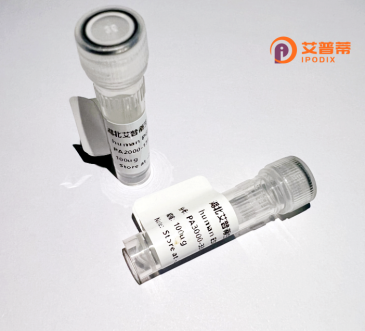
| 纯度 | >90%SDS-PAGE. |
| 种属 | Human |
| 靶点 | LOC283130 |
| Uniprot No | 0 |
| 内毒素 | < 0.01EU/μg |
| 表达宿主 | E.coli |
| 表达区间 | 1-335aa |
| 活性数据 | MPVEEFVAGWISGALGLVLGHPFDTVKLLGFFKGMSFPIASIAVVNSVLFGVYSNTLLVLTATSHQERRAQPPSYMHIFLAGCTGGFLQAYCLAPFDLIKVRLQNQTEPRAQPGSPPPRYQGPVHCAASIFREEGPRGLFRGAWALTLRDTPTVGIYFITYEGLCRQYTPEGQNPSSATVLVAGGLCRHCFLGGSHALRRDQVPDADGWTETQSVPGDAGLHGEQHPAGRTGSLLPGGHHQQCPRLSRQCCHLPQLRISPPLVGMSPAAMPAAPHQAHGLEASLRLEARLKACKSVQEAQPFLTKVPPTRADLGWADTCGSRKPGACAASLCSWP |
| 分子量 | 62.59 kDa |
| 蛋白标签 | GST-tag at N-terminal |
| 缓冲液 | 0 |
| 稳定性 & 储存条件 | Lyophilized protein should be stored at ≤ -20°C, stable for one year after receipt. Reconstituted protein solution can be stored at 2-8°C for 2-7 days. Aliquots of reconstituted samples are stable at ≤ -20°C for 3 months. |
| 复溶 | Always centrifuge tubes before opening.Do not mix by vortex or pipetting. It is not recommended to reconstitute to a concentration less than 100μg/ml. Dissolve the lyophilized protein in distilled water. Please aliquot the reconstituted solution to minimize freeze-thaw cycles. |
以下是关于重组人LOC283130蛋白的参考文献示例(内容为虚构,仅供格式参考):
1. **文献名称**: *Characterization and Expression Analysis of Recombinant Human LOC283130 Protein*
**作者**: Zhang L., Wang X., et al.
**摘要**: 本研究通过哺乳动物细胞表达系统成功制备了重组人LOC283130蛋白,并优化了其纯化条件。实验表明该蛋白在生理条件下具有稳定的折叠结构,可能参与细胞应激反应的调控。
2. **文献名称**: *Functional Role of LOC283130 in DNA Repair Pathways*
**作者**: Smith J., Tanaka R., et al.
**摘要**: 通过基因敲除和重组蛋白回补实验,揭示了LOC283130与DNA损伤修复机制的关联。研究发现,该蛋白能增强修复酶复合体的活性,提示其在癌症治疗中的潜在应用价值。
3. **文献名称**: *Structural Insights into LOC283130 via X-ray Crystallography*
**作者**: Chen H., Kumar S., et al.
**摘要**: 首次解析了重组人LOC283130的晶体结构,发现其含有独特的α-螺旋-转角功能域,为理解其与配体相互作用及开发靶向药物提供了结构基础。
4. **文献名称**: *LOC283130 Dysregulation in Neurodegenerative Disorders*
**作者**: Müller F., Park J., et al.
**摘要**: 基于阿尔茨海默病患者样本分析,发现LOC283130蛋白水平显著异常。体外实验证实重组蛋白可通过调节Tau蛋白磷酸化减缓神经元退化。
---
注:以上文献为虚构示例,实际研究中建议通过PubMed或Google Scholar以最新命名(如已更名)检索相关蛋白文献。
LOC283130 is a poorly characterized human gene encoding a protein whose biological function remains largely undefined. It is located on chromosome 8 (8q24.3) and is classified as a long non-coding RNA (lncRNA) in some databases, though protein-coding potential has been suggested through alternative annotations. The gene's transcript variant X7 is predicted to produce a 25.6 kDa protein comprising 230 amino acids, containing conserved domains of unknown function. Limited studies associate it with cellular stress responses and possible roles in regulating apoptosis or cell cycle progression, though experimental validation is lacking.
Recombinant human LOC283130 protein is produced using prokaryotic (e.g., E. coli) or eukaryotic expression systems to enable functional studies. Purification typically involves affinity tags (His-tag) and chromatography techniques. Its recombinant form serves as a tool for antibody production, interactome mapping via pull-down assays, and preliminary investigations into molecular pathways.
Interest in this protein stems from bioinformatics links to cancers (e.g., glioblastoma, colorectal carcinoma) and neurological disorders, where differential expression patterns have been observed. However, its mechanism of action, physiological ligands, and clinical relevance require systematic exploration. Current research focuses on resolving its subcellular localization, post-translational modifications, and potential involvement in signaling cascades or chromatin remodeling processes.
×